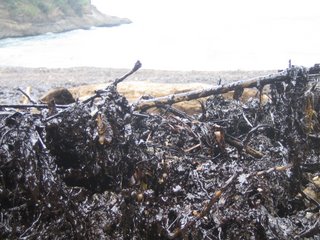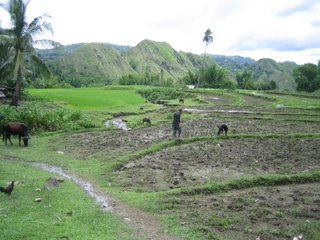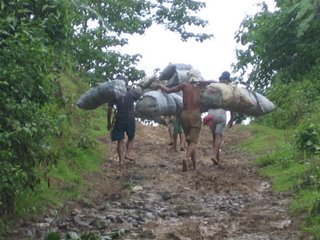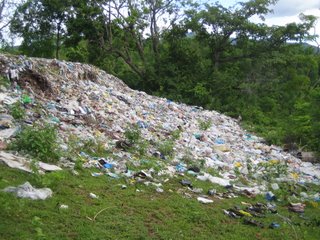The Job, Family, and Dengue Fever…
It’s been two months at my site now and in typical Filipino fashion I’m just now getting around to updating the details. To start off I will talk about my work. It’s been real slow thus far and I now understand why Peace Corps informed us not to expect much output in the first three months. Although there are several problems in San Joaquin I’ve decided to focus my primary efforts on solid waste management and water related projects.
Solid waste management (SWM) is one of the biggest problems throughout the entire Philippines and my town is no exception. In fact, it was the reason my host agency, Local Government Unit of San Joaquin, requested a volunteer in the first place. I have spent most of my time researching different SWM topics including waste segregation techniques, composting, and landfill design. I’ve also been spending time in the community observing the current practices and problems. As of now there is no waste segregation at the market or household level. We currently have an open dump for the town. Its problems include that it is a great source for dengue breeding mosquitoes, it is inaccessible most of the year (in which case the trash is dumped along a river bank), and it located in a natural water shed on a steep slope. There is no regular collection schedule, or segregation of collection by the LGU or barangays. As a result, many people choose to either burn or dispose of their trash in the rivers. One of the most disheartening things I discovered was that two years ago the town and most of the municipality was actually practicing proper solid waste management. Each barangay had an established Material Recovery Facility (MRF) where waste was segregated at the neighborhood level for re-use and recycling. The former mayor had made it her platform that San Joaquin be known as a model SWM community. However, none of these programs were sustained with the arrival of the current mayor and her administration. It’s not that the mayor does not care about the SWM problems; it’s just that it was her opponent’s platform and as a result she seeks to pump money and effort into other projects to make her own name. This has already begun to make my job difficult but I’m doing my best to work through it. I managed to hold a meeting with the Ecological Solid Waste Management Board (ESWMB), department heads of the LGU, the five barangay captains of the town proper, and the school principals within the town proper. Although the ESWMB existed (due to an ordinance created by the previous mayor) it was the first time they had convened for a meeting in two years. I gave a brief presentation discussing the various SWM problems I had uncovered along with backing pictures. Many people at the meeting had failed to recognize how serious the problem was until they saw some of the photos (no one had ever seen the open dump). After the presentation I did my best to facilitate an open discussion…this was rather challenging since people can understand English but prefer to speak Kinaray-a and I was using something in between the two. I made sure to try and get everyone’s opinion especially the barangay captains’ since they often feel neglected by the LGU. Overall it was a good first meeting but just a small step in a big process to come.
As big as the solid waste problems are, I have too much time on my hands to focus solely on just that. This is because I’m constantly waiting on others or meetings to be finalized, and in the Philippines these things happen slowly. Therefore, I spend a lot of the down time either studying my language, going out and meeting people in the town, or visiting barangays with water issues and giving consultation. For the most part, the latter has consisted of doing simple hydraulic calculations to determine necessary pipe sizes for water supply systems. I also visited a barangay deep in the mountains that was looking to build a small dam for the use of irrigation in the summer months. This was one of the best days I have had here given that this visit required a two hour hike through some gorgeous country. It also provided me with an opportunity to see some extremely rural areas where life has changed little in the past few hundred years. Farmers still plow their fields with carabaw and walk miles through the mountains to deliver their rice in town. I find it ironic that I can take a 1 ½ hour jeep ride into the city and basically have all the amenities of home or a take a 1 ½ hour hike into the mountains and have virtually nothing at all.
Although work has been difficult, I have managed to find two counterparts in the office that get things done. The first is my Nanay (mother) Erlyn. She likes to brag that I’m her "newly adopted blue eyed son". She’s about 46 and works as the community affairs and tourism officer of San Joaquin. One of her best traits is that unlike most Filipinos she speaks her mind if she thinks people are lacking in work productivity (which is usually everybody most of the time). She claims this gets her in trouble but it also seems to get people to work. She has also been my primary tutor for my continual learning of Kinaray-a. Rodel is my other counterpart and at 28 years old he is one of the youngest in the office. Unlike Erlyn, he prefers to avoid confrontation in the office but still manages to motivate others to get things done. I have been trying to learn from his example as best as I can.
My new host family has grown on me, but it is still not the sense of family I experienced during my training in Guimbal. My host mom Sally is about 70 and has one son of 35, Joe-An, as well as a 16 year old adopted daughter named Jeralynn. Sally is really a sweet little old lady who enjoys stuffing me full of Filipino food any chance she gets. Mealtimes are still a bit unconventional for me since I eat either alone or with Joe-An when he is around. The rest of the family, including the 17 year old maid Anna eats after us. I still don’t like the idea of having a maid (or ya-ya) wait on me but if she was not working for Sally she wouldn’t have a job to help provide for her family as well as three meals a day, a nice place to sleep, and the opportunity to still go to school. A lot of kids in this town would love to have that chance. At the same time it is difficult to hear everyone nag at her all the time; especially Jeralynn, who if had not been adopted would be in the same if not worse situation (a little reminiscent of Cinderella)…I guess that’s just life and its one more thing that makes me appreciate how lucky I had it growing up.
So like the title suggests I have experienced my first major bout with a virus serious enough to put me in the hospital. Two weeks ago I was spending the evening with my former language teacher Roli and some of his mountaineering buddies. The plan was to spend the night on a beautiful beach in San Joaquin and then hike a mountain the next morning. That night I came down with a major fever and the worse headache of my life. We were a bit secluded with no cell phone reception so I decided to try to sleep it off and see how I felt the next morning. After a sleepless night I headed out of there as soon as I could and caught a jeep back to town. From there my host brother Joe-An was nice enough to drive me to the city which made a usual 1 ½ hour drive only 45 minutes. Once at the hospital the rookie nurse struggled a bit to get my IV in (it took him four tries), but overall I felt relieved to be there after spending the previous night under an open cottage in a rainstorm. For the first two days at the hospital my fever fluctuated between 38-39.5C (99.5-102F). I also had minor joint and lower back pain but overall I wasn’t too bad. The third day they released me and informed me I had some kind of viral infection. I spent that night and the next day at home resting. The following morning I awoke with red rashes on my hands and arms. I went the clinic in San Joaquin to get a blood analysis and the Doc concluded that my platelets were way too low and I should head back to the hospital. So back to Iloilo I went and after taking more blood they concluded that I did in fact have Dengue Fever. They kept me there for another three days to recuperate. Overall my hospital experience was not too bad. I had cable TV and air conditioning for 6 days. The Peace Corps also provides you with another volunteer kasama (companion) and extra spending money beyond my regular allowance. Since I had no stomach problems I was living it up on fast food, deli sandwiches, and lots of ice cream (note: I think hospital food may be bad everywhere in the world). I have heard agonizing tales about Dengue from other volunteers so I consider myself lucky that my symptoms for the most part were limited to a fever and headache.
On a more positive note I think I visited my future home today. It’s a small cottage right on the beach in a barangay about 10 kilometers from town. Living in the town proper has been alright but I really miss that feeling of being in a small community like I experienced during training. I still have a few more places to see but this one will be hard to beat. It has running water from a spring, a nice indoor bathroom, electricity, two good sized rooms, and most importantly it is right on the beach. This may be the only time in my life I’ll be able to fall asleep every night to the sound of waves crashing. I still have another month to stay with my host family but then I’m free to move out on my own. Also, my bike frame that I ordered two months ago has finally arrived. By some miracle the shop actually found me a 23in frame…I’m excited!
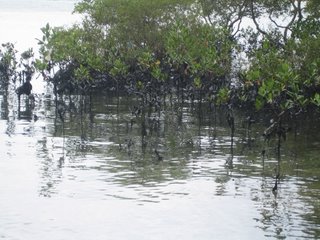
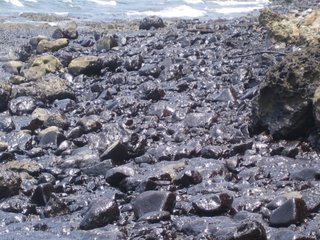 .
.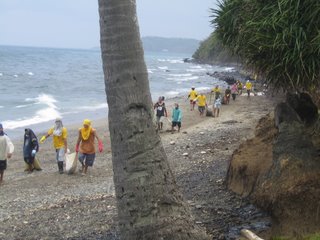 Here are some more pictures of the mess
Here are some more pictures of the mess